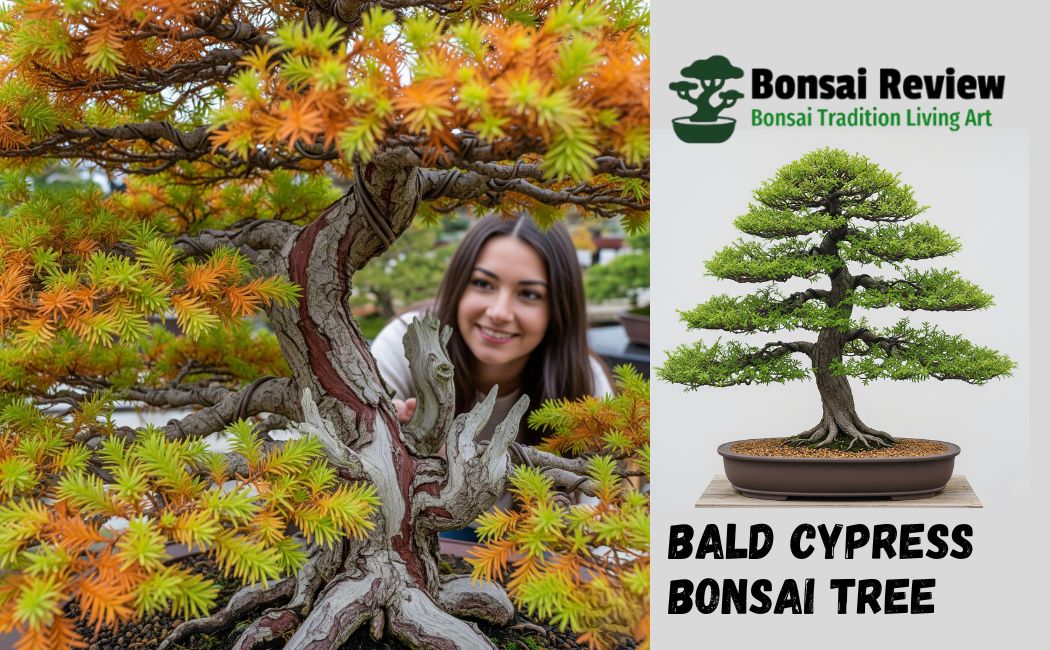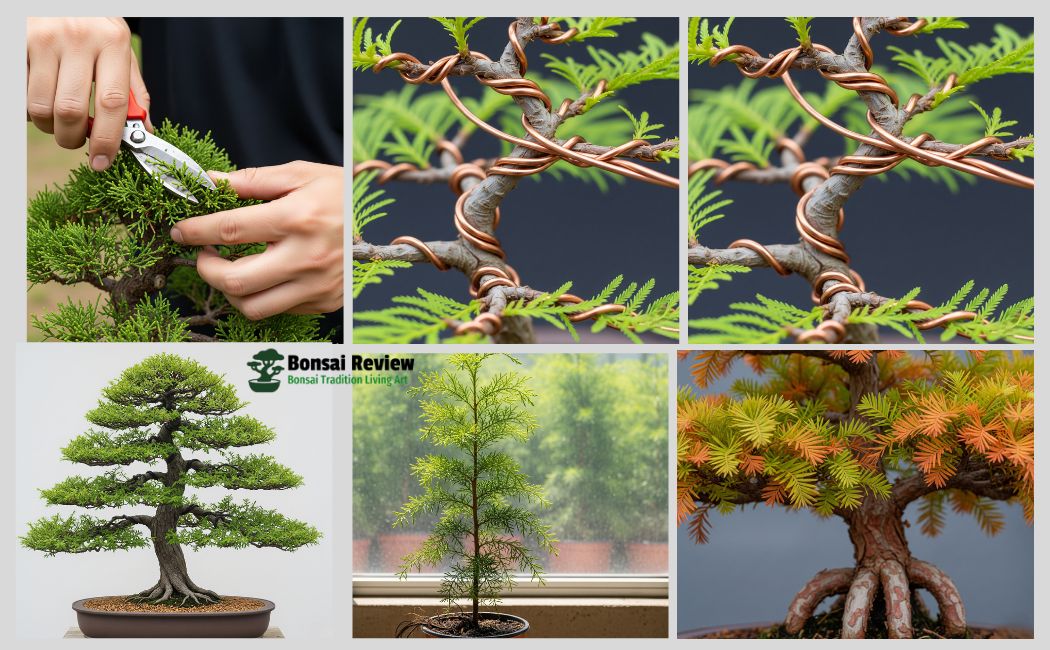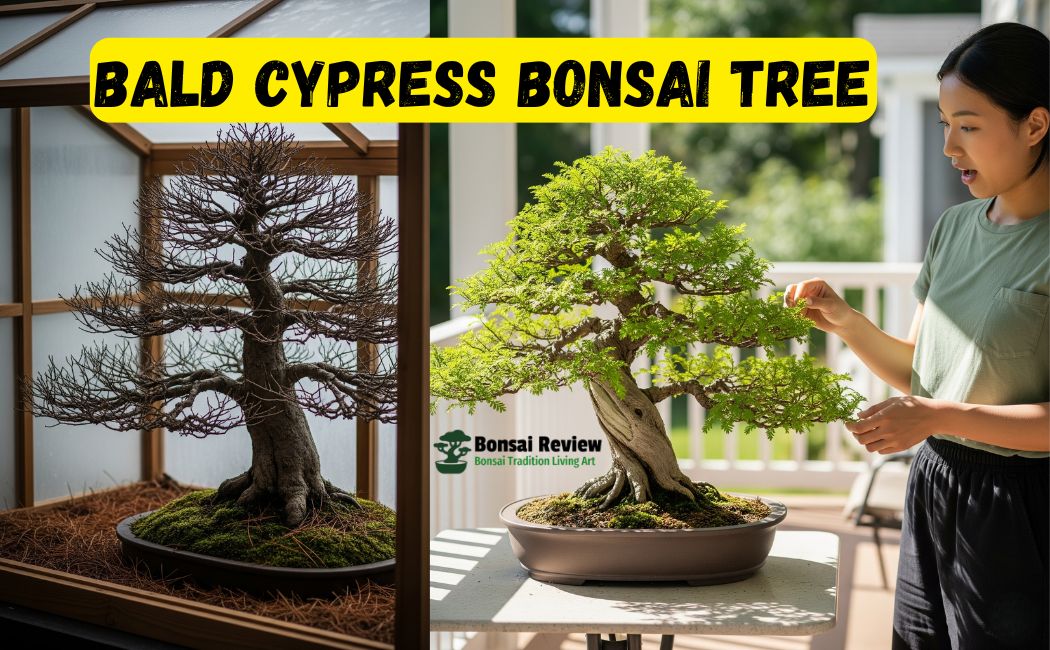The Bald Cypress (Taxodium distichum) is so easy to grow! Bald Cypress Bonsai Tree: A member of the Redwood family, Taxodiaceae. It is a primary tree species and can reach heights of 100-120′ with a trunk diameter typically between 3-5′. It is one of the best bonsai trees for beginner dwarf plant lovers.
The bald cypress tiny plant that can be cultivated in a wide range of soils, from boggy marsh sites to well-drained areas where it would not grow naturally. This low-maintenance, moisture-loving tree is excellent for the bonsai beginner and Outdoor plant lovers.
The Bald cypress bonsai tree indoor decor. It is very popularly used for lumber and making furniture, because it has powerful anti-fungal properties. It is non-toxic for both cats and dogs, making it a safe addition to your home or office indoor garden if you have pets.
Regular vet check-ups can help detect any unforeseen issues with plants and pet interactions early on. Other plants in your garden may not all be pet-safe like the Bald cypress.
Can cypress bonsai trees grow in the USA? Yes, you can commonly find the southeastern United States, the cypress tree (Taxodium spp.) is a deciduous conifer that can survive in standing water.
The Bald Cypress (Taxodium distichum) grows in many areas of Louisiana and Florida, particularly in swampy areas. The Bald Cypress has been designated the official tree of the state of Louisiana and the Florida Everglades. These trees are often found growing in one of three distinct formations.
As a testament to its hardiness, the bald cypress is often planted as a street tree because it can grow well even in areas of higher pollution, flash stormwater runoff, and compacted soil.
In some cultures, the bald cypress symbolizes longevity, endurance, and mourning. Bald cypress trees are valued for the rot-resistant heartwood of mature trees. Because of this, wood and trees are often used for making fence posts, doors, flooring, caskets, and a number of other items.
What Is a Bald Cypress Bonsai Tree?
You’re not just growing a tree, you’re raising a living piece of wetland history. The bald cypress bonsai tree comes from the Taxodium distichum species, a deciduous conifer that drops its leaves every fall but stands tall year after year.
In the wild, it grows in swampy wetlands, especially around the Mississippi River, where its roots push up strange, knobby cypress knees through the muddy ground. These knees don’t just look cool, they help the tree breathe and stay stable.
As a bonsai, the bald cypress is full of character. Its feathery needles turn rusty orange in autumn, then fall away as the tree enters dormancy. Its bark starts reddish-brown and stringy, and with time, it becomes rough and deeply textured, just like an ancient tree should look.
What makes it even more special is how well it grows in both well-drained bonsai soil and standing water. It’s one of the few bonsai that actually enjoys wet feet!
Even better? This species grows fast. That means a thick trunk, bold branches, and real shape in less time. If you want to try a formal upright, flat-top, or even root-over-rock style, this tree gives you the freedom to create something bold. It’s tough, cold-hardy, and surprisingly beginner-friendly, a rare combo in the bonsai world.

How to Care for a Bald Cypress Bonsai Tree?
Caring for a bald cypress bonsai tree is easier than you think, especially if you’ve struggled with fussy bonsai before. This tree is tough, fast-growing, and loves water. But like any living thing, it still needs the right setup. Here’s what to do:
1. Sunlight For Bald Cypress Bonsai Trees.
Your bald cypress bonsai tree loves full sun. Place it outside where it can soak up sunlight most of the day. It can handle partial shade, but bright light helps it grow stronger and keeps those feathery needles healthy.
2. Watering: The Tough Bald Cypress Bonsai Tree that Loves Water.
The bald cypress bonsai tree is one of the only bonsai trees that can sit in standing water without problems. In fact, it thrives in it! During hot months, you can even place the pot in a shallow tray of water. Just avoid waterlogging in freezing temps.
3. Soil: What is the Best Soil for a Bald Cypress Bonsai Tree?
A heavy soil is best, such as a compact mushroom compost. If the tree is not kept in water, a heavy soil is a must since it needs to retain as much moisture as possible. You cannot rot cypress roots!
Since bald cypress’ preferred habitat is low, swampy terrain, flat, shallow, earth-colored pots are recommended. Use a well-draining mix made for bonsai.
A blend of akadama, pumice, and lava rock works well. If you want to grow it swamp-style, go ahead and let it sit in water part-time. It won’t complain.
4. Fertilizer: Well Feed Your Plants, Provide the Best Impact.
Feed it with a balanced fertilizer every two weeks during spring and summer. As the tree slows down in fall, reduce feeding. No fertilizer during winter dormancy, the tree is resting.
5. Pruning & Wiring: Styling & Shaping Bald Cypress Bonsai Tree.
You’ll need to prune regularly to shape your tree and build ramification (lots of tiny branches). You can wire branches to set direction, but be gentle; this tree grows fast, and wires can cut in quickly.
6. Winter Care: Bald Cypress Bonsai Tree.
Even though it’s cold hardy, protect the roots if you live in a freezing zone (Zone 5–6). Put the pot in a cold frame or mulch it into the ground. Indoors, only use a cool, bright spot, not near heaters or dry air.
Tips Bald Cypress Bonsai Tree Care: Needle browning in winter? It’s normal. Bald cypress bonsai tree goes to sleep and drops its leaves like other deciduous trees.
Now you can grow that same deciduous conifer right in a pot, yes, even if you live somewhere cold. This tree drops its soft, feathery needles in fall, but don’t worry, it’s just resting for winter. It loves full sun, soaks up water like a sponge, and even grows well in standing water.
With just a bit of care, the reddish-brown bark turns rough and bold with age, the roots grow strong, and the tree slowly becomes a story you shape.
If you’re a beginner or just tired of delicate trees, this water-loving bonsai can handle your learning curve and still come out looking like a miniature swamp giant.

How Can Make Styling & Shaping Your Bald Cypress Bonsai Tree?
Once your bald cypress bonsai tree is growing strong, it’s time to shape its story. This tree grows fast, so you’ll have lots of chances to prune, wire, and create a design that matches its natural beauty.
Because of its buttressed trunk, feathery foliage, and fast-growing habit, bald cypress fits well with bold, upright shapes or natural swampy designs. You can go with a formal look or let it mimic how it grows in the wild.
The flat-top style, for example, copies the way mature bald cypress trees look in southern swamps, tall with wide branches that flatten out on top.
Use wiring early in the growing season when branches are young and flexible. Always check wires often since this tree grows quickly, wire marks can appear fast. To create movement in the trunk, start early and be gentle.
What are the Best Styling Options for a Bald Cypress Bonsai Tree?
The bald cypress bonsai tree is your water-loving mini swamp giant. A bald cypress bonsai tree might be the answer if you’re looking for a strong, fast-growing tree that forgives your mistakes and still looks wild and beautiful.
| Style Name | Look & Feel | Why It Works for Bald Cypress |
| Formal Upright | Straight trunk, balanced branches | Matches the tree’s strong central growth |
| Informal Upright | Gently curved trunk, natural flow | Great for showing off wild character |
| Flat-Top Style | Horizontal top branches, tall trunk | Mimics old trees in Louisiana swamps |
| Root-over-Rock | Roots grow over a stone, gripping it | Works well with its strong roots and knees |
| Group Planting | Mini forest with 3+ trees | Creates a natural swamp scene with tall, thin trunks |
| Broom Style (Rare) | Fan-shaped branch layout from a straight trunk | Harder to do, but possible with heavy ramifications |
Tip: Let lower branches grow thick first. They help develop the nebari (surface root flare) and base. Later, you can prune or style them for more shape.
Starting from Scratch: Sapling, Cutting, or Collected?
Ready to grow your bald cypress bonsai tree? Good news, it’s flexible. You can begin with a sapling, a cutting, or even a tree collected from the wild (where legal). No matter where you start, this tree grows fast, which means you’ll see results sooner than with slower bonsai species.
Option 1: Nursery Sapling: Easiest Beginner Bonsai Lover
Buying a young bald cypress from a bonsai shop or nursery is the simplest way to start. These usually already have a straight trunk and a healthy root base. You can begin pruning and wiring the shape right away.
Option 2: Cutting: Proper Season for Bald Cypress Bonsai Tree.
You can grow one from a cutting taken in late spring or early summer. Place the cutting in water or moist soil, keep it warm and humid, and it should root in a few weeks. This method is cheaper and fun, but takes longer to get a thick trunk.
Option 3: Collected Tree: Advanced Method.
In wet zones like the southeastern U.S., you might be able to collect a tree from the wild (with permission). These trees often come with natural buttress roots and are perfect for showing off the tree’s wild, swampy look.

Tips for Developing Structure with Bald Cypress Bonsai Tree Cultivation.
| Step | What to Do | Why It Matters |
| Let the lower branches grow | Don’t prune early | Builds a strong trunk base (nebari) |
| Trunk chop (optional) | Cut the top for a thicker lower trunk | Common bonsai technique |
| Use deep pots | Give room for strong roots | Bald cypress grows fast below the soil |
| Keep the soil wet | Encourages knee formation | Best in shallow water or swamp setup |
| Pinch new shoots | Helps with branch ramification | Builds leaf density and branch pads |
However, Bald cypress can grow cypress knees over time, but only in wet conditions. If you want those cool knobby roots, try placing your bonsai pot in a shallow water tray for part of the growing season.
Cold Weather? No Problem (But Do This First)
If you live in a place where winters get cold, don’t worry, your bald cypress bonsai tree is tougher than it looks. This tree is cold hardy down to around 25°F (-4°C), which makes it a great choice if you’re in USDA Hardiness Zones 5–10. Still, like all bonsai, it needs a little extra help when the cold hits hard.
What Happens in Winter?
In fall, the tree will go into dormancy. Its soft, feathery needles will turn brown and fall off. That’s normal, it’s not dying, just sleeping! During dormancy, the tree needs less water and no fertilizer.
Protecting Your Tree in Cold Climates
| Your Winter Conditions | What To Do |
| Light frost (above 25°F) | Leave it outside, and protect the pot with mulch |
| Freezing temps (below 25°F) | Move it to a cold frame, garage, or unheated shed |
| Snowy zones | Bury the pot in the ground or use thick insulation |
| Indoor setup (only if needed) | Use a cool, bright room not heated or dry |
What to Avoid?
- Never bring it into a warm living room: The tree needs cold to rest.
- Don’t overwater in winter: Wet soil + freezing = root damage.
- Don’t leave it exposed in the wind or icy rain: The tree is hardy, but roots in a small pot freeze faster than those in the ground.
Tip: If you’re in a hot zone, this tree handles temperatures above 90°F (32°C) just fine, too; just give it full sun and plenty of water.
Bald Cypress Bonsai Tree: Easy Care Tips, Styling, and Common Fixes.
Common Problems with Bald Cypress Bonsai Tree + Quick Fixes. Even though the bald cypress bonsai tree is tough, sometimes you’ll face challenges. The good news? Most problems have simple solutions if you spot them early.
| Problem | Cause | How to Fix It |
| Needle browning | Dry air, underwatering, or too much sun | Increase humidity with a tray, water regularly, and provide some shade during the hottest hours |
| Leaf drop outside fall | Overwatering or poor drainage | Check soil moisture, improve drainage, and reduce watering |
| Root rot | Waterlogged soil in cold weather | Improve drainage, reduce watering, and repot if needed |
| No knees forming | The soil is too dry, or the tree is not in enough water | Keep roots in shallow water or wet soil during the growing season |
| Pests: aphids, mites, scale | Infestation on leaves or branches | Use insecticidal soap, neem oil, or wipe leaves carefully |
| Wire marks | Wiring left on too long | Remove or adjust wires regularly to avoid scarring |
Suggest: The bald cypress is resilient but responds best to regular care and attention. Watch your bonsai closely, and you’ll catch problems before they get serious.
Conclusion: Why the Bald Cypress Bonsai Tree Could Be Your Best Bonsai Yet?
The bald cypress bonsai tree is more than just a pretty plant. It’s a strong, fast-growing, and cold-hardy little swamp giant you can shape and care for at home. With its unique cypress knees, soft feathery needles, and rough reddish-brown bark, it tells a story of resilience and beauty.
Whether you’re a beginner or have tried bonsai before, this tree’s love for standing water, ability to handle different soils, and forgiving nature make it a perfect match. You’ll watch it grow thick trunks and bold branches faster than many other bonsai species.
So, if you want a bonsai that feels alive, wild, and full of character, the bald cypress is ready to be your new bonsai buddy. All it takes is a bit of sun, water, and patience, and you’ll have a tiny swamp forest to call your own.
Get a more informative article: How to Grow Dwarf Sagittaria Grass Carpet in Your Indoor Aquarium Like a Pro!
FAQs: Mastering the Bald Cypress Bonsai Tree: From Knees to Crown.
1. Can you grow a bald cypress bonsai tree indoors?
It’s best to keep your bald cypress bonsai outside where it gets plenty of sun and humidity. Indoors, it’s hard to provide enough light and moisture for it to thrive.
2. How long does it take for a bald cypress bonsai tree to develop knees?
Knees usually start forming after 2 to 3 years if the tree’s roots stay in wet or swampy conditions.
3. Is the bald cypress bonsai tree good for beginners?
Yes! Bald Cypress Bonsai Tree for beginners is tough, grows fast, and recovers well from mistakes, making it a great choice for new bonsai growers.
4. What are the benefits of bald cypress trees?
The bald cypress has no medicinal uses; it is very popularly used for lumber and making furniture, because it has powerful anti-fungal properties. The wood of the Bald Cypress is also strong and heavy, making it great for outdoor construction as it is resistant to shrinkage, rotting, and termites.
4 Why is my bald cypress bonsai losing its needles?
If it’s fall or winter, this is normal. The bald cypress is a deciduous conifer, so it drops needles to rest during dormancy.
5. Can keep bald cypress bonsai tree be kept in standing water?
Absolutely. Bald cypress bonsai tree naturally grows in swampy areas and can handle pots sitting in shallow water, especially during the growing season.
6. Can bald cypress be grown indoors?
If it is desirable to bring your Bald Cypress grove indoors, it should only be for very limited periods in a bright southern-facing location. That receives ample sunlight, and not during its natural dormancy period.
7. What is the spiritual meaning of the bald cypress tree?
In spiritual tradition, the bald cypress is known as a symbol of mourning, death, and the path of the dark forest. Many caskets are customarily made from bald cypress.